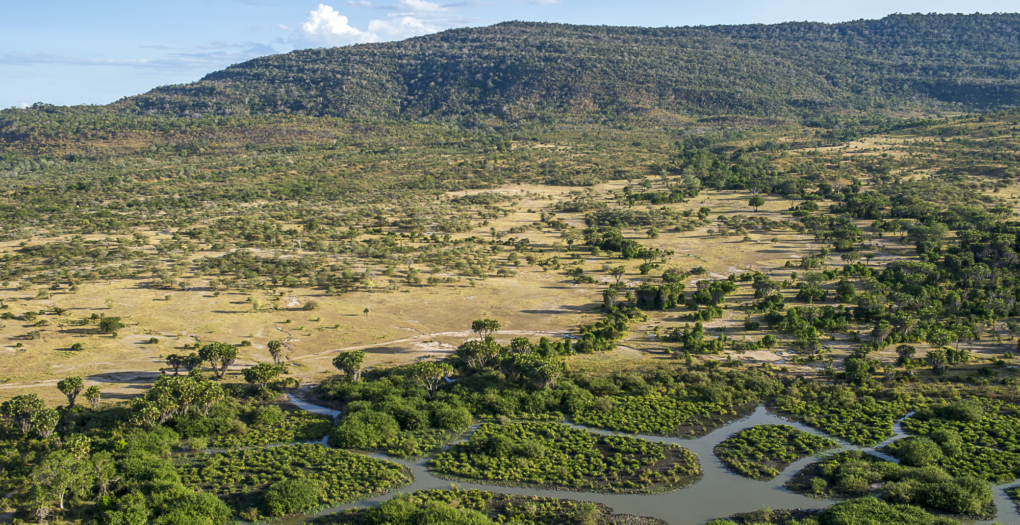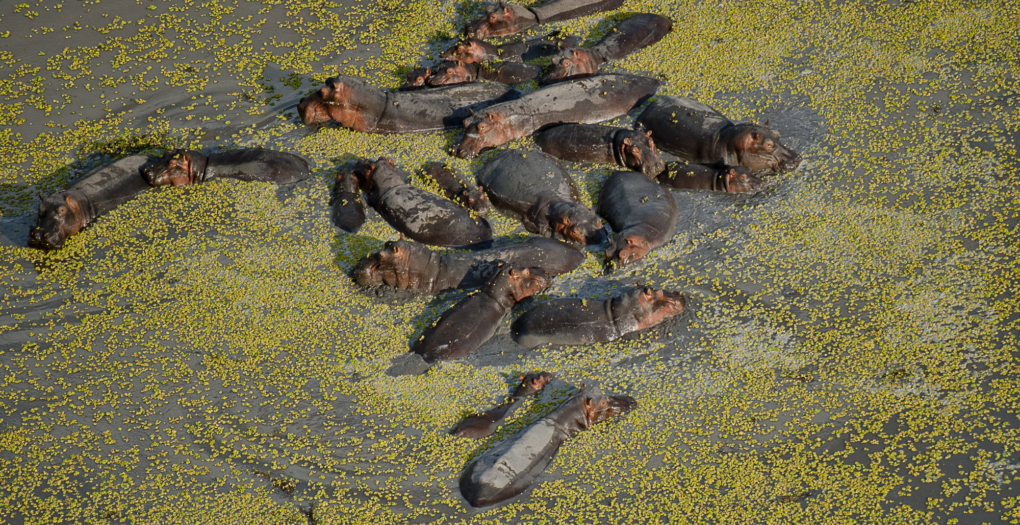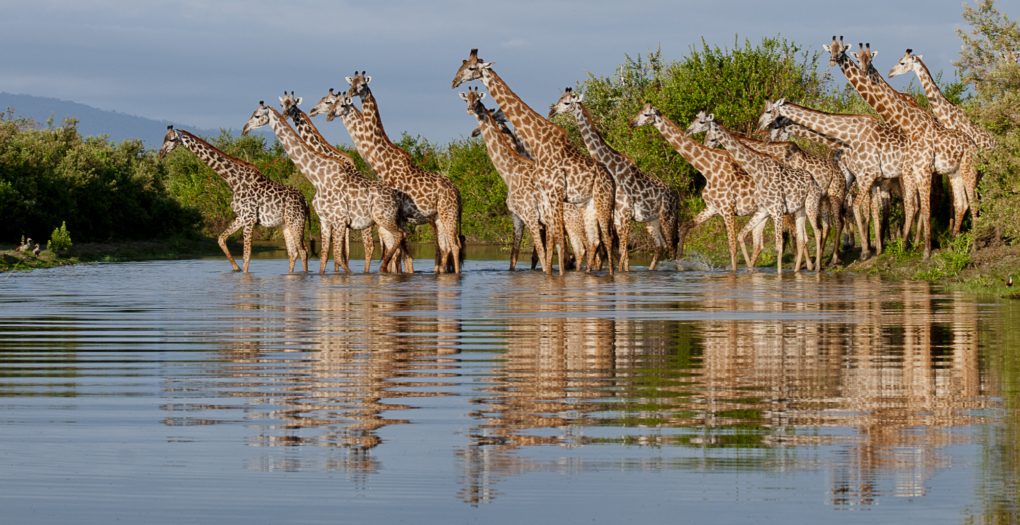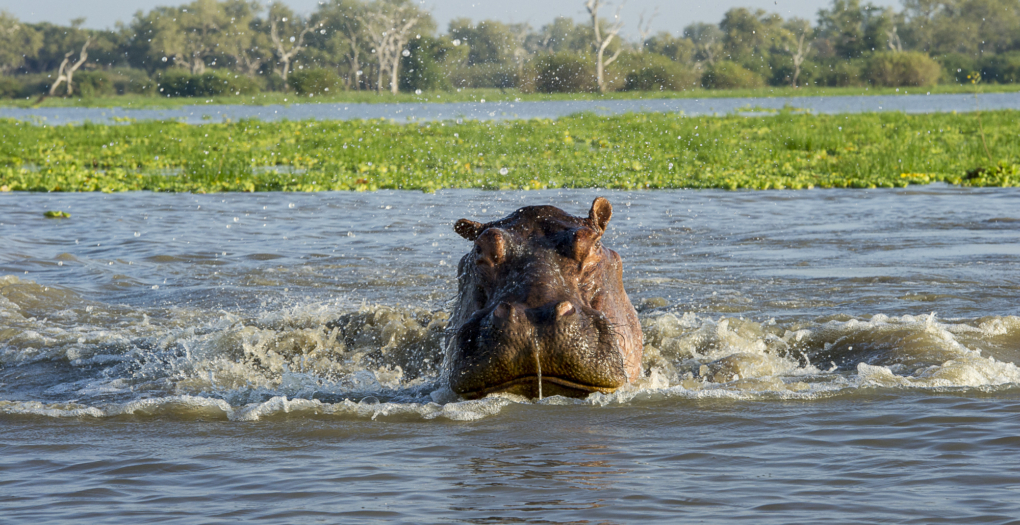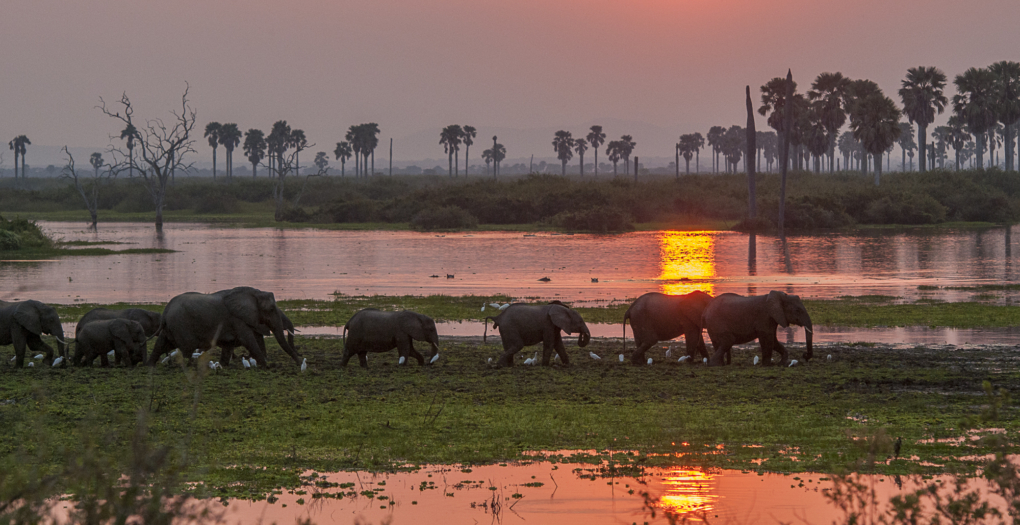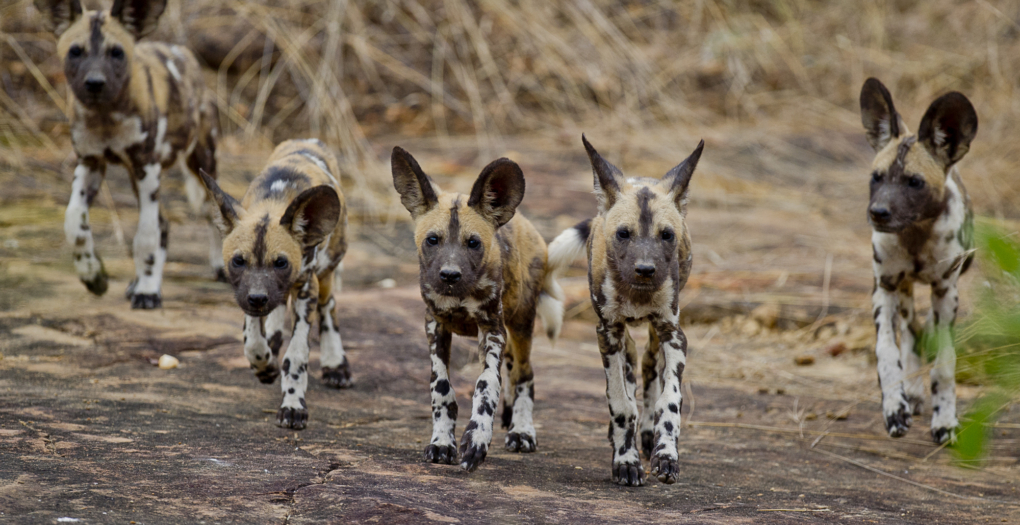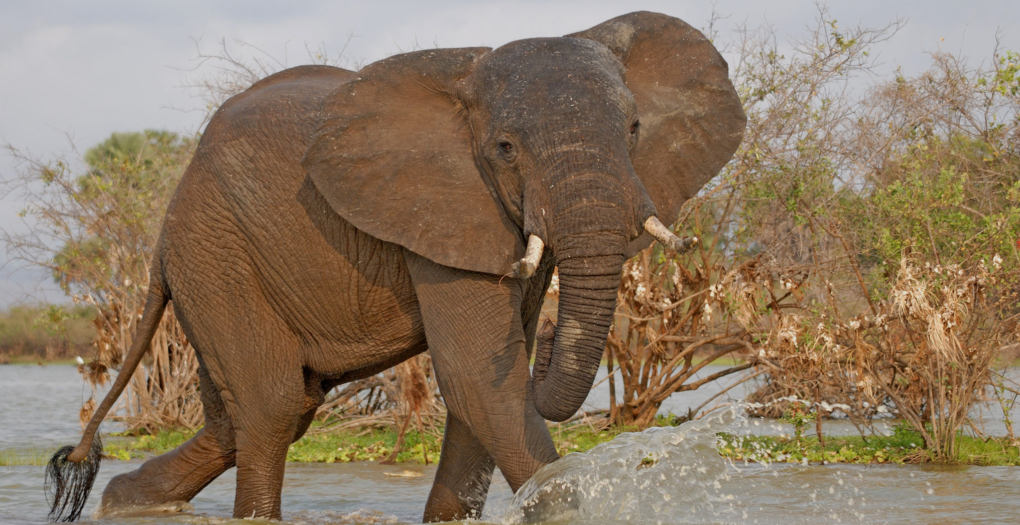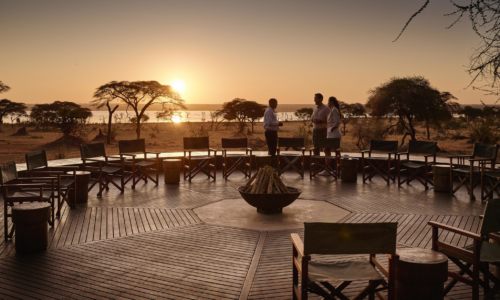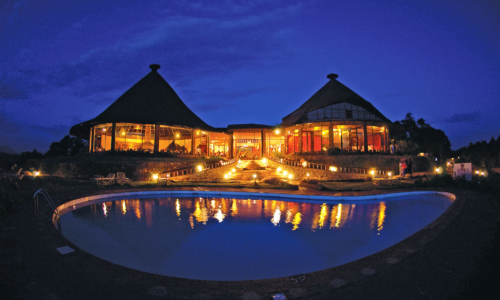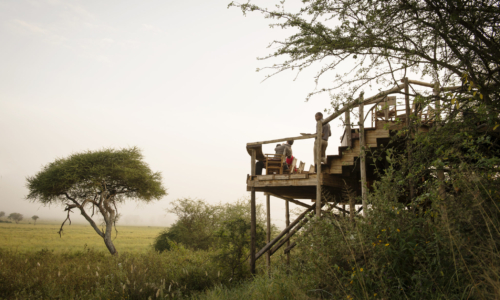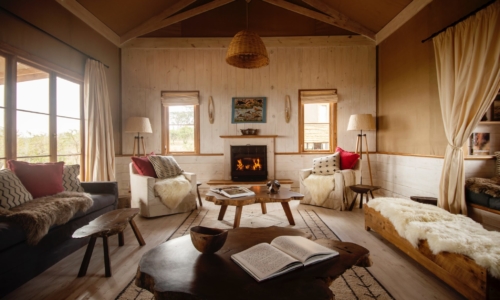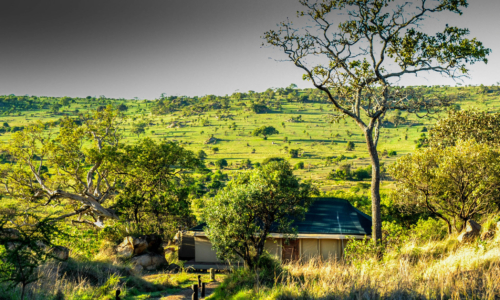This protected region was originally established in 1922 and was named for Frederick Courteney Selous. Selous was a British explorer, hunter, and conservationist who perished near the Rufiji River while fighting German colonial forces in the First World War. Designated a UNESCO World Heritage Site in 1982 due to its wildlife diversity and undisturbed environment, the reserve bore the name of Selous for 97 years, until is was renamed in 2019 after Tanzania’s founding father, Julius Nyerere.
Today, the national park encompasses an area of over 11,500 square miles, not counting additional buffer zones, which is over twice the size of the more famous Serengeti National Park. Because of its size and its more remote location, Nyerere is much quieter and exclusive, with fewer tourists per square mile than the parks in the northern parts of the country. To this day it remains remarkably wild and untouched.
Nyerere’s size makes it difficult to estimate the true extent of the wildlife within its borders. But its rivers and lakes sustain phenomenal wildlife concentrations, including Africa’s largest populations of elephant and wild dog. Along the Rufiji River and beyond, an astonishing number of animal and bird species can be found including waterbuck, reedbuck, bushbuck, crocodile, hippo, and black and white colobus monkeys. Sandbanks are crowded with huge crocodiles, exposed mud banks are shaded under red clouds of carmine bee-eaters, and swampy islands are visited by wandering elephants.
Magnificent sickle-horned sable and curly-horned greater kudu tend to keep to the longer grass and wooded shrubby areas. The dry season sees an ancient elephant migration from the this area to Mozambique’s Niassa Game Reserves. This journey crosses one of the largest natural trans-boundary eco-systems in Africa, and at the last consensus it was estimated that 64,400 elephants roam the two parks, with 84% happening on the Tanzanian side.
There are plenty of activities to enjoy in the park. Safari camps in the park feature daily game drives in 4×4 vehicles, guided by expert guides and trackers. Uniquely, walking safaris are permitted in the park. Boat trips on the Rufiji are also popular. Navigating the network of lakes and rivers by boat provides an unusual perspective on the terrain and allow the animals to remain undisturbed by your presence. Fishing the rivers in the park is extremely enjoyable as anglers search for fierce tiger fish and giant vundu catfish which can exceed 100 pounds. The vundu is marvelously equipped with primitive lungs that enable it to cross land for short distances in search of a new home as the pools shrink during the dry season. The park also allows wild camping, which puts guests in even more remote and rustic settings (always under the supervision of camp staff and an armed guard nearby).

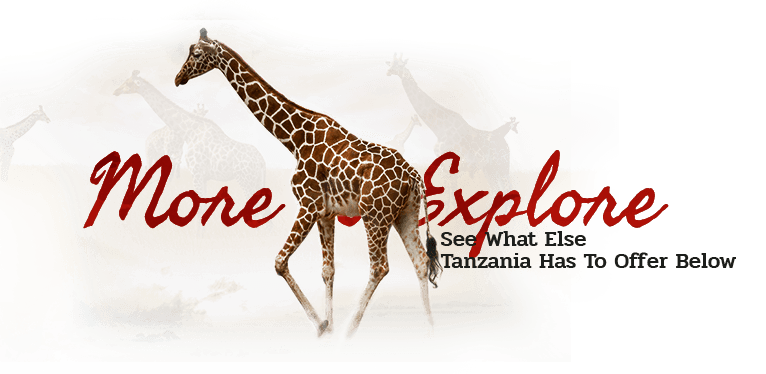
- Bashay Rift Lodge
- Beho Beho Camp
- Chada Katavi
- Chaka Camp
- Chem Chem Lodge
- Dunia Camp
- Entamanu Ngorongoro
- Entamanu Private
- Esirai Camp
- Ewanjan Tented Camp
- Faru Faru Lodge
- Forest Chem Chem
- Fumba Beach Lodge
- Fundu Lagoon
- Gibb’s Farm
- Greystoke Mahale
- Grumeti Hills
- Grumeti Serengeti River Lodge
- Ikuka Safari Camp
- Jabali Ridge
- Jongomero
- Kaskaz Mara Camp
- Kiba Point Selous
- Kichaka
- Kichakani Serengeti Camp
- Kichuguu Camp
- Kigelia Ruaha
- Kilima
- Kiota Camp
- Kisima Ngeda Camp
- Kitela Lodge
- Klein’s Camp
- Kokoko Camp
- Kuria Hills Lodge
- Kuro Tarangire
- Kusini Kopjes Kambi
- Kusini Serengeti
- Kwihala Camp
- Lake Manyara Tree Lodge
- Lamai Serengeti
- Little Chem Chem
- Little Oliver’s Camp
- Manyara Ranch Conservancy
- Mara River Post
- Mara River Tented Camp
- Mara Tented Camp
- Maweninga Camp
- Melia Ngorongoro
- Mila Tented Camp
- Milele
- Mkombe’s House
- Mnemba Island
- Mpingo Ridge Lodge
- Mwiba Lodge
- Namiri Plains
- Naona Moru Camp
- Nasikia Mobile Camp
- Ndutu Safari Lodge
- Ndutu Tented Camp
- Ngorongoro Crater Camp
- Ngorongoro Crater Lodge
- Ngorongoro Serena Safari Lodge
- Ngorongoro Sopa Lodge
- Ngorongoro Tented Camp
- Nomad Expeditionary Walking Camp
- Nyasi Tented Camp
- Olaado Camp
- Olakira Migration Camp
- Olduvai Camp
- Olduvai Ndogo
- Oliver’s Camp
- Olkeri Camp
- Olmara Camp
- Roho ya Selous
- Ronjo Camp
- Rubondo Island Camp
- Sabora Tented Camp
- Sanctuary Serengeti Migration Camp
- Sand Rivers Selous
- Sasakwa Lodge
- Sayari Camp
- Selous Serena Camp
- Serena Mivumo River Lodge
- Serengeti Bushtops
- Serengeti House
- Serengeti Kati Kati Tented Camp
- Serengeti Migration Camp
- Serengeti Pioneer Camp
- Serengeti Safari Camp
- Serengeti Under Canvas
- Serian’s Serengeti
- Serian’s Serengeti Mobile
- Singita Explore
- Singita Kilima
- Siwandu
- Songa Migrational Camp
- Swala
- Taasa Lodge
- Tarangire Ndovu Tented Lodge
- Tarangire Safari Lodge
- Tarangire Sopa Lodge
- Tarangire Treetops
- The Highlands
- The Manor at Ngorongoro
- Ubuntu Migration Camp
- Usangu Expedition Camp
- Usawa Serengeti
- Arumeru Lodge
- Arusha Coffee Lodge
- Baraza Resort & Spa
- Breezes Beach Club & Spa
- Chole Mjini
- Dar es Salaam Serena Hotel
- Fanjove Island
- Hamerkop House
- Katambuga House
- Kilindi Zanzibar
- Lake Duluti Lodge
- Legendary Lodge
- Matemwe Beach House
- Matemwe Lodge
- Matemwe Retreat
- Ngare Sero Mountain Lodge
- Oyster Bay Hotel
- Plantation Lodge
- Rivertrees Country Inn
- The Palms
- Zanzibar Serena Hotel
- Zawadi Hotel
- Zuri Zanzibar
Coming soon!
- Bashay Rift Lodge
- Beho Beho Camp
- Chada Katavi
- Chaka Camp
- Chem Chem Lodge
- Dunia Camp
- Entamanu Ngorongoro
- Entamanu Private
- Esirai Camp
- Ewanjan Tented Camp
- Faru Faru Lodge
- Forest Chem Chem
- Fumba Beach Lodge
- Fundu Lagoon
- Gibb’s Farm
- Greystoke Mahale
- Grumeti Hills
- Grumeti Serengeti River Lodge
- Ikuka Safari Camp
- Jabali Ridge
- Jongomero
- Kaskaz Mara Camp
- Kiba Point Selous
- Kichaka
- Kichakani Serengeti Camp
- Kichuguu Camp
- Kigelia Ruaha
- Kilima
- Kiota Camp
- Kisima Ngeda Camp
- Kitela Lodge
- Klein’s Camp
- Kokoko Camp
- Kuria Hills Lodge
- Kuro Tarangire
- Kusini Kopjes Kambi
- Kusini Serengeti
- Kwihala Camp
- Lake Manyara Tree Lodge
- Lamai Serengeti
- Little Chem Chem
- Little Oliver’s Camp
- Manyara Ranch Conservancy
- Mara River Post
- Mara River Tented Camp
- Mara Tented Camp
- Maweninga Camp
- Melia Ngorongoro
- Mila Tented Camp
- Milele
- Mkombe’s House
- Mnemba Island
- Mpingo Ridge Lodge
- Mwiba Lodge
- Namiri Plains
- Naona Moru Camp
- Nasikia Mobile Camp
- Ndutu Safari Lodge
- Ndutu Tented Camp
- Ngorongoro Crater Camp
- Ngorongoro Crater Lodge
- Ngorongoro Serena Safari Lodge
- Ngorongoro Sopa Lodge
- Ngorongoro Tented Camp
- Nomad Expeditionary Walking Camp
- Nyasi Tented Camp
- Olaado Camp
- Olakira Migration Camp
- Olduvai Camp
- Olduvai Ndogo
- Oliver’s Camp
- Olkeri Camp
- Olmara Camp
- Roho ya Selous
- Ronjo Camp
- Rubondo Island Camp
- Sabora Tented Camp
- Sanctuary Serengeti Migration Camp
- Sand Rivers Selous
- Sasakwa Lodge
- Sayari Camp
- Selous Serena Camp
- Serena Mivumo River Lodge
- Serengeti Bushtops
- Serengeti House
- Serengeti Kati Kati Tented Camp
- Serengeti Migration Camp
- Serengeti Pioneer Camp
- Serengeti Safari Camp
- Serengeti Under Canvas
- Serian’s Serengeti
- Serian’s Serengeti Mobile
- Singita Explore
- Singita Kilima
- Siwandu
- Songa Migrational Camp
- Swala
- Taasa Lodge
- Tarangire Ndovu Tented Lodge
- Tarangire Safari Lodge
- Tarangire Sopa Lodge
- Tarangire Treetops
- The Highlands
- The Manor at Ngorongoro
- Ubuntu Migration Camp
- Usangu Expedition Camp
- Usawa Serengeti
- Arumeru Lodge
- Arusha Coffee Lodge
- Baraza Resort & Spa
- Breezes Beach Club & Spa
- Chole Mjini
- Dar es Salaam Serena Hotel
- Fanjove Island
- Hamerkop House
- Katambuga House
- Kilindi Zanzibar
- Lake Duluti Lodge
- Legendary Lodge
- Matemwe Beach House
- Matemwe Lodge
- Matemwe Retreat
- Ngare Sero Mountain Lodge
- Oyster Bay Hotel
- Plantation Lodge
- Rivertrees Country Inn
- The Palms
- Zanzibar Serena Hotel
- Zawadi Hotel
- Zuri Zanzibar
Coming soon!

This protected region was originally established in 1922 and was named for Frederick Courteney Selous. Selous was a British explorer, hunter, and conservationist who perished near the Rufiji River while fighting German colonial forces in the First World War. Designated a UNESCO World Heritage Site in 1982 due to its wildlife diversity and undisturbed environment, the reserve bore the name of Selous for 97 years, until is was renamed in 2019 after Tanzania’s founding father, Julius Nyerere.
Today, the national park encompasses an area of over 11,500 square miles, not counting additional buffer zones, which is over twice the size of the more famous Serengeti National Park. Because of its size and its more remote location, Nyerere is much quieter and exclusive, with fewer tourists per square mile than the parks in the northern parts of the country. To this day it remains remarkably wild and untouched.
Nyerere’s size makes it difficult to estimate the true extent of the wildlife within its borders. But its rivers and lakes sustain phenomenal wildlife concentrations, including Africa’s largest populations of elephant and wild dog. Along the Rufiji River and beyond, an astonishing number of animal and bird species can be found including waterbuck, reedbuck, bushbuck, crocodile, hippo, and black and white colobus monkeys. Sandbanks are crowded with huge crocodiles, exposed mud banks are shaded under red clouds of carmine bee-eaters, and swampy islands are visited by wandering elephants.
Magnificent sickle-horned sable and curly-horned greater kudu tend to keep to the longer grass and wooded shrubby areas. The dry season sees an ancient elephant migration from the this area to Mozambique’s Niassa Game Reserves. This journey crosses one of the largest natural trans-boundary eco-systems in Africa, and at the last consensus it was estimated that 64,400 elephants roam the two parks, with 84% happening on the Tanzanian side.
There are plenty of activities to enjoy in the park. Safari camps in the park feature daily game drives in 4×4 vehicles, guided by expert guides and trackers. Uniquely, walking safaris are permitted in the park. Boat trips on the Rufiji are also popular. Navigating the network of lakes and rivers by boat provides an unusual perspective on the terrain and allow the animals to remain undisturbed by your presence. Fishing the rivers in the park is extremely enjoyable as anglers search for fierce tiger fish and giant vundu catfish which can exceed 100 pounds. The vundu is marvelously equipped with primitive lungs that enable it to cross land for short distances in search of a new home as the pools shrink during the dry season. The park also allows wild camping, which puts guests in even more remote and rustic settings (always under the supervision of camp staff and an armed guard nearby).

- Bashay Rift Lodge
- Beho Beho Camp
- Chada Katavi
- Chaka Camp
- Chem Chem Lodge
- Dunia Camp
- Entamanu Ngorongoro
- Entamanu Private
- Esirai Camp
- Ewanjan Tented Camp
- Faru Faru Lodge
- Forest Chem Chem
- Fumba Beach Lodge
- Fundu Lagoon
- Gibb’s Farm
- Greystoke Mahale
- Grumeti Hills
- Grumeti Serengeti River Lodge
- Ikuka Safari Camp
- Jabali Ridge
- Jongomero
- Kaskaz Mara Camp
- Kiba Point Selous
- Kichaka
- Kichakani Serengeti Camp
- Kichuguu Camp
- Kigelia Ruaha
- Kilima
- Kiota Camp
- Kisima Ngeda Camp
- Kitela Lodge
- Klein’s Camp
- Kokoko Camp
- Kuria Hills Lodge
- Kuro Tarangire
- Kusini Kopjes Kambi
- Kusini Serengeti
- Kwihala Camp
- Lake Manyara Tree Lodge
- Lamai Serengeti
- Little Chem Chem
- Little Oliver’s Camp
- Manyara Ranch Conservancy
- Mara River Post
- Mara River Tented Camp
- Mara Tented Camp
- Maweninga Camp
- Melia Ngorongoro
- Mila Tented Camp
- Milele
- Mkombe’s House
- Mnemba Island
- Mpingo Ridge Lodge
- Mwiba Lodge
- Namiri Plains
- Naona Moru Camp
- Nasikia Mobile Camp
- Ndutu Safari Lodge
- Ndutu Tented Camp
- Ngorongoro Crater Camp
- Ngorongoro Crater Lodge
- Ngorongoro Serena Safari Lodge
- Ngorongoro Sopa Lodge
- Ngorongoro Tented Camp
- Nomad Expeditionary Walking Camp
- Nyasi Tented Camp
- Olaado Camp
- Olakira Migration Camp
- Olduvai Camp
- Olduvai Ndogo
- Oliver’s Camp
- Olkeri Camp
- Olmara Camp
- Roho ya Selous
- Ronjo Camp
- Rubondo Island Camp
- Sabora Tented Camp
- Sanctuary Serengeti Migration Camp
- Sand Rivers Selous
- Sasakwa Lodge
- Sayari Camp
- Selous Serena Camp
- Serena Mivumo River Lodge
- Serengeti Bushtops
- Serengeti House
- Serengeti Kati Kati Tented Camp
- Serengeti Migration Camp
- Serengeti Pioneer Camp
- Serengeti Safari Camp
- Serengeti Under Canvas
- Serian’s Serengeti
- Serian’s Serengeti Mobile
- Singita Explore
- Singita Kilima
- Siwandu
- Songa Migrational Camp
- Swala
- Taasa Lodge
- Tarangire Ndovu Tented Lodge
- Tarangire Safari Lodge
- Tarangire Sopa Lodge
- Tarangire Treetops
- The Highlands
- The Manor at Ngorongoro
- Ubuntu Migration Camp
- Usangu Expedition Camp
- Usawa Serengeti
- Arumeru Lodge
- Arusha Coffee Lodge
- Baraza Resort & Spa
- Breezes Beach Club & Spa
- Chole Mjini
- Dar es Salaam Serena Hotel
- Fanjove Island
- Hamerkop House
- Katambuga House
- Kilindi Zanzibar
- Lake Duluti Lodge
- Legendary Lodge
- Matemwe Beach House
- Matemwe Lodge
- Matemwe Retreat
- Ngare Sero Mountain Lodge
- Oyster Bay Hotel
- Plantation Lodge
- Rivertrees Country Inn
- The Palms
- Zanzibar Serena Hotel
- Zawadi Hotel
- Zuri Zanzibar
Coming soon!
- Bashay Rift Lodge
- Beho Beho Camp
- Chada Katavi
- Chaka Camp
- Chem Chem Lodge
- Dunia Camp
- Entamanu Ngorongoro
- Entamanu Private
- Esirai Camp
- Ewanjan Tented Camp
- Faru Faru Lodge
- Forest Chem Chem
- Fumba Beach Lodge
- Fundu Lagoon
- Gibb’s Farm
- Greystoke Mahale
- Grumeti Hills
- Grumeti Serengeti River Lodge
- Ikuka Safari Camp
- Jabali Ridge
- Jongomero
- Kaskaz Mara Camp
- Kiba Point Selous
- Kichaka
- Kichakani Serengeti Camp
- Kichuguu Camp
- Kigelia Ruaha
- Kilima
- Kiota Camp
- Kisima Ngeda Camp
- Kitela Lodge
- Klein’s Camp
- Kokoko Camp
- Kuria Hills Lodge
- Kuro Tarangire
- Kusini Kopjes Kambi
- Kusini Serengeti
- Kwihala Camp
- Lake Manyara Tree Lodge
- Lamai Serengeti
- Little Chem Chem
- Little Oliver’s Camp
- Manyara Ranch Conservancy
- Mara River Post
- Mara River Tented Camp
- Mara Tented Camp
- Maweninga Camp
- Melia Ngorongoro
- Mila Tented Camp
- Milele
- Mkombe’s House
- Mnemba Island
- Mpingo Ridge Lodge
- Mwiba Lodge
- Namiri Plains
- Naona Moru Camp
- Nasikia Mobile Camp
- Ndutu Safari Lodge
- Ndutu Tented Camp
- Ngorongoro Crater Camp
- Ngorongoro Crater Lodge
- Ngorongoro Serena Safari Lodge
- Ngorongoro Sopa Lodge
- Ngorongoro Tented Camp
- Nomad Expeditionary Walking Camp
- Nyasi Tented Camp
- Olaado Camp
- Olakira Migration Camp
- Olduvai Camp
- Olduvai Ndogo
- Oliver’s Camp
- Olkeri Camp
- Olmara Camp
- Roho ya Selous
- Ronjo Camp
- Rubondo Island Camp
- Sabora Tented Camp
- Sanctuary Serengeti Migration Camp
- Sand Rivers Selous
- Sasakwa Lodge
- Sayari Camp
- Selous Serena Camp
- Serena Mivumo River Lodge
- Serengeti Bushtops
- Serengeti House
- Serengeti Kati Kati Tented Camp
- Serengeti Migration Camp
- Serengeti Pioneer Camp
- Serengeti Safari Camp
- Serengeti Under Canvas
- Serian’s Serengeti
- Serian’s Serengeti Mobile
- Singita Explore
- Singita Kilima
- Siwandu
- Songa Migrational Camp
- Swala
- Taasa Lodge
- Tarangire Ndovu Tented Lodge
- Tarangire Safari Lodge
- Tarangire Sopa Lodge
- Tarangire Treetops
- The Highlands
- The Manor at Ngorongoro
- Ubuntu Migration Camp
- Usangu Expedition Camp
- Usawa Serengeti
- Arumeru Lodge
- Arusha Coffee Lodge
- Baraza Resort & Spa
- Breezes Beach Club & Spa
- Chole Mjini
- Dar es Salaam Serena Hotel
- Fanjove Island
- Hamerkop House
- Katambuga House
- Kilindi Zanzibar
- Lake Duluti Lodge
- Legendary Lodge
- Matemwe Beach House
- Matemwe Lodge
- Matemwe Retreat
- Ngare Sero Mountain Lodge
- Oyster Bay Hotel
- Plantation Lodge
- Rivertrees Country Inn
- The Palms
- Zanzibar Serena Hotel
- Zawadi Hotel
- Zuri Zanzibar
Coming soon!







